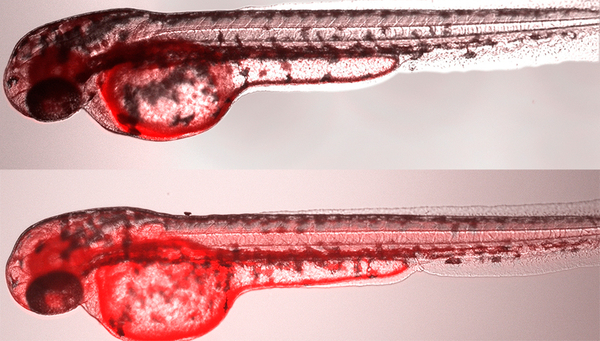Archive detail
Fish Embryos Possess a Mechanism for Protection against Chemicals
September 3, 2013 |
Fish possess a number of different mechanisms for protection against harmful substances in an aquatic environment. These include, for example, molecular transport systems, such as the so called ABC (ATP binding cassette) transporters, which prevent the penetration of toxic substances into cells. ABC transporters have been well investigated for mammals. For fish and their embryos, however, little is known about such transporters. Ecotoxicologists Dr. Till Luckenbach (UFZ) and Dr. Stephan Fischer (Eawag) together with other colleagues have now found that the transport protein Abcb4 actively extrudes chemicals from the embryo of the zebrafish (Danio rerio). "A fish embryo already has effective protective capabilities", says Luckenbach. "The importance of such transport systems is generally underestimated in toxicological and ecotoxicological research – but they play a very important role."
When a substance is bound to zebrafish Abcb4 , this triggers cleavage of the energy transfer substance adenosine triphosphate (ATP). The energy which this sets free is utilised to expel this substance from the cell. Abcb4 can repel a multitude of different chemical compounds, as a result of which the embryo is resistant to a multitude of toxic substances. In humans the protein ABCB1 serves this function. Thus, it came as a sur-prise that it is Abcb4 that in zebrafish acts as “multidrug” or “multixenobiotic” trans-porter. The homologous ABCB4 of humans, by contrast, is incapable of transporting toxic chemical compounds. Instead, human ABCB4 has a specific function in liver where it channels certain fatty acids into the bile ducts in order to protect the liver cells against aggressive biliary acids.
In experiments with zebrafish embryos in which the expression of Abcb4 protein was suppressed, Luckenbach and his team found that the embryos were much more sensi-tive to toxic chemicals and that these substances were enriched to a greater extent in the embryo tissue. "Based on this data we concluded that the zebrafish Abcb4 protects the embryo against the toxic impact of chemicals by keeping them out", says Luckenbach.
In follow-on investigations the researchers measured the activity of the transport sys-tem, enabling the identification of the chemicals which Abcb4 transports. However, cer-tain substances block the transport mechanism. This inhibition renders its function ineffective, and other harmful substances can penetrate into the organism. "Compounds which inhibit the transporter throw open the doorway for other toxic substances ", says Stephan Fischer." These are also referred to as chemosensitizers, as they make the organism more sensitive to harmful chemicals. This indirect toxic effect plays an important role, above all in mixtures of substances such as frequently found in our environment."
At the UFZ a wide range of environmentally relevant chemicals are currently being in-vestigated for their impact on the Abcb4 transporter system – separately and in mix-tures. Luckenbach: "Many effects of substance mixtures may be explained on the basis of the zebrafish Abcb4 protein activity. Zebrafish embryos are used for the assessment of chemicals and for investigations of environmental impact, so we hope that in future our study will contribute to an awareness of the need to incorporate Abcb4 transport processes in toxicological testing directives."
Images of zebrafish (Danio rerio) embryos illustrating the function of the transporter protein Abcb4 acting as effective chemical defense by keeping out chemical compounds from the embryos. When exposed to the red, fluorescent dye rhodamine B little dye accumulates in the cells and tissues of the fish embryos because Abcb4 prevents uptake of the dye as can be seen in the image above. When transporter function is disrupted by a chemical inhibitor considerably more dye accumulates in the embryo tissues – the embryo tissues appear brighter as the image below shows. Abcb4 acts as uptake barrier for a range of toxic chemicals and protects the fish embryos from their toxic impact. However, similar to cyclosporin A, which here was used as transporter inhibitor, also other chemical compounds, including man-made pollutants, inhibit Abcb4 function and thus cause increased sensitivity of fish embryos to toxicants.
Publication
Abcb4 acts as multixenobiotic transporter and active barrier against chemical uptake in zebrafish (Danio rerio) embryos. Stephan Fischer, Nils Klüver, Kathleen Burkhardt-Medicke, Mirko Pietsch, Anne-Marie Schmidt, Peggy Wellner, Kristin Schirmer and Till Luckenbach BMC Biology 2013, 11:69 doi:10.1186/1741-7007-11-69
http://www.biomedcentral.com/1741-7007/11/69



